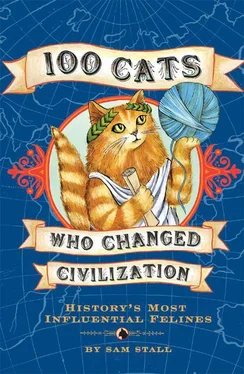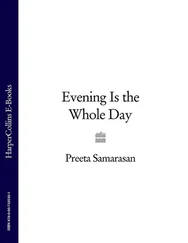COBBY
THE CAT WHO STOLE HIS MASTER’S HEART—LITERALLY

After the death of English poet and novelist Thomas Hardy on January 11, 1928, his pet cat, Cobby, reportedly vanished, never to be seen again. This strange occurrence gave rise to one of the most macabre stories in the history of Western literature.
It began shortly after the great man’s passing, when a contest broke out over where to bury his body. Hardy’s will stated explicitly that he wanted to be laid to rest with minimal ceremony in his hometown of Stinsford. However, the executor of his will thought that the author of such classics as Tess of the d’Urbervilles , The Mayor of Casterbridge , and The Return of the Native should enjoy more august accommodations. Specifically, he wanted Hardy to find repose in the fabled Poet’s Corner of Westminster Abbey, near such luminaries as Charles Dickens, Geoffrey Chaucer, and Dr. Samuel Johnson.
After heated debate with the family, a compromise was reached: Hardy’s body would go to Westminster Abbey and his heart to Stinsford. This would require a bit of postmortem surgery—a job that Hardy’s personal physician reportedly declined to undertake. Another doctor was found, and the organ was removed while the great author lay in state at his home. Tradition says it was wrapped in a tea cloth, placed in a biscuit tin, and set aside for transport.
According to one version of the story, the next day the undertaker charged with carrying the heart to Stinsford discovered the box was empty and Cobby was nowhere to be found—the assumption being, of course, that the cat ran off with his owner’s heart. But there’s an even more horrifying telling of the tale. Some contend that, on the fateful day, authorities found the box empty save for a few scraps of flesh—and that Cobby sat nearby, washing the blood off his muzzle.
In this version of the story, the undertaker came up with a rough-and-ready solution. He had to bury the heart. The heart was inside Cobby. So he throttled the poor cat and secretly interred him at Stinsford. How much of the story is true? Only an inspection of the grave’s contents could answer that question. But what is known for sure is that poor Cobby was never seen again.
POLAR BEAR
THE CAT WHO CHARMED A CURMUDGEON

Cleveland Amory was a well-known literary figure throughout his life. He was the youngest-ever editor at the Saturday Evening Post , chief critic for TV Guide , and the author of such bestsellers as The Proper Bostonians and Who Killed Society? But it took a New York City tomcat to turn him into a household name.
It happened on Christmas Eve 1977, when Amory, an avowed dog person, helped rescue an injured stray cat lurking in an alley near his apartment. The cat rewarded his effort by slashing him across both hands. Nevertheless, Amory adopted him. He discovered, while bathing the extraordinarily dirty creature, that it was snow white. Accordingly, he named him Polar Bear.
The two became fast friends, and the cat became an invaluable partner in Amory’s long-running crusade for animal rights. Over the years Amory had done everything from cofounding the Humane Society of the United States to launching the Fund for Animals, dedicated to protecting rare and endangered wildlife. Those causes received an enormous boost in 1988, when he published a book about his life with Polar Bear called The Cat Who Came for Christmas . It rocketed to No. 1 on the New York Times bestseller list, as did its two sequels, The Cat and the Curmudgeon and The Best Cat Ever .
The works turned Polar Bear into a celebrity among cat fans and animal rights activists. He was even invited to become ship’s cat aboard the Greenpeace vessel Sea Shepherd (an offer that Amory, on his pet’s behalf, respectfully declined). Perhaps most importantly, he cast light on his owner’s animal rights work, including a scheme to airlift burros out of the Grand Canyon to save them from government culling and an effort to paint seal pups with harmless dyes to make their pelts worthless to trappers.
The two parted ways in 1991, when Polar Bear passed away. He was buried at Black Beauty Ranch, a Texas refuge established by the Fund for Animals to care for abused and abandoned creatures. His memorial reads, “Beneath these stones lie the mortal remains of The Cat Who Came for Christmas, Beloved Polar Bear. ’Til we meet again.” They met again when Amory, who died in 1998, was laid to rest beside him.
MYSOUFF II
THE CAT WHO ATE THE CANARIES

French novelist Alexandre Dumas, the author of such classics as The Three Musketeers, The Man in the Iron Mask , and The Count of Monte Cristo , was famous for his high living and bizarre exploits. So when his cat, Mysouff II, displeased him, he was given a punishment perfectly in keeping with his owner’s imaginative nature. Luckily for him, it was too imaginative to execute.
Mysouff II was actually the second cat in this feline dynasty. The original Mysouff had been at Dumas’ side when he was just starting out as a writer. Every day the feline would see his master off to work, and every evening he met Dumas at the corner to escort him home. The cat would unerringly meet him at the same spot, even if he arrived before or after his usual time.
After the passing of this faithful original came Mysouff II, a black and white shorthaired feline who was discovered in the basement of Dumas’ home by a cook. By then the author had become rich and famous, and he lived in luxury. Mysouff II also enjoyed plenty of pampering—until he found a way to mess up a good thing. Among Dumas’ many, many indulgences was a collection of monkeys and another of exotic birds that lived on the property. One day the cat found his way into the aviary and proceeded to consume the entire flock.
Dumas was horrified, but also somewhat amused. He decided to put the offending feline on trial for the crime. The next Sunday he argued the case before a handpicked “jury” of friends. During the trial someone pointed out an extenuating circumstance: The aviary door had been opened by one of the monkeys, and the feline had simply taken advantage of the situation.
Since the simians were clearly implicated as accomplices, Dumas decided that poor Mysouff II should spend the next five years imprisoned with them. But fate spared him from incarceration. Shortly after the cat started serving his sentence, the author suffered a huge financial setback. A round of belt tightening followed, and the expensive monkeys and their cage were put on the auction block. Mysouff II not only got to stay, but also won early parole.
JEOFFREY
THE WORLD’S MOST GODLY CAT

Pity poor Christopher Smart. An English poet born in 1722, Smart began writing award-winning verses during his years as a student at Cambridge University. Sadly, he was also drinking excessively, running up debts, and hiding from creditors. After graduating, he edited and wrote for various London publications, sometimes adopting bizarre pseudonyms such as Mary Midnight. Around 1751, he experienced a religious conversion, which coincided more or less with a descent into madness. He began accosting passersby in London’s Hyde Park, demanding that they immediately get down on their knees and pray with him. His odd behavior landed him in a mental asylum from 1756 to 1758.
Читать дальше













